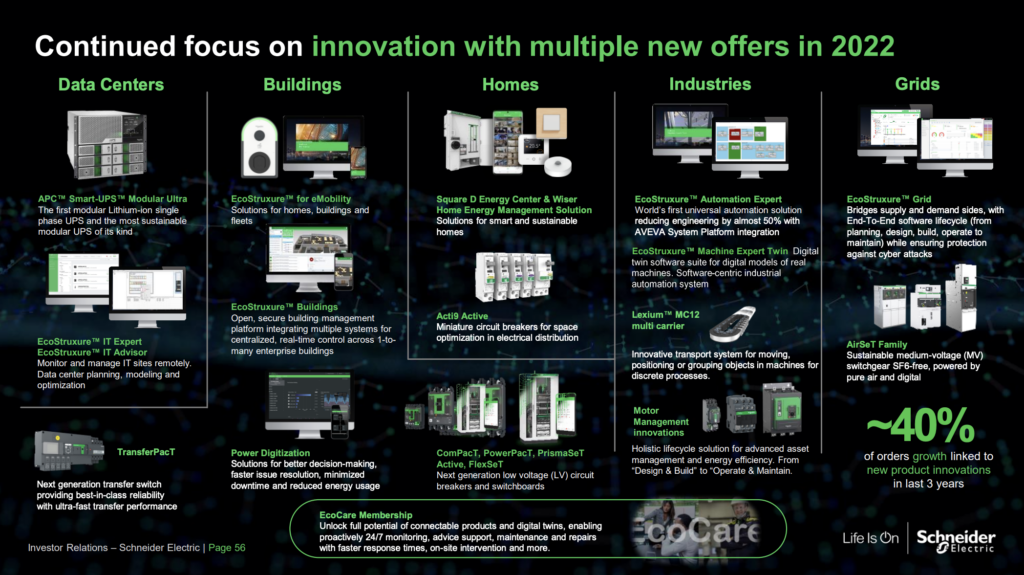In this Research Note, we examine the Buildings business of Schneider Electric, based on their 2022 Full Year Results, presentations and significant activities and strategy in the smart buildings space throughout 2022.
Buildings are one of four end markets that Schneider Electric addresses with a complete portfolio of products, solutions and services. In its Q4 2022 performance by end-market commentary, Schneider Electric reported that it continues to see overall good demand in the buildings end-market with continued strength in non-residential, while in residential markets the very strong demand of recent years is now beginning to normalize.
Strong sales growth was supported by supply chain easing, resulting in backlog execution. Performance in non-residential was supported by demand in the technical building and hotel segments, while renovation trends and decarbonization commitments continue to underpin this end-market.
The Buildings end market of Schneider Electric is addressed by a portfolio of products, systems, software and services offered by the Energy Management (EM) division. The Energy Management division reported €26.4 billion in revenues for 2022, a 12.9% organic growth versus the prior year. While Schneider Electric does not report the business mix for its EM division, Memoori estimates that electrical and power distribution products and systems account for the majority of revenues in this division.
The building automation portfolio of Schneider Electric is estimated to generate revenues in the range of $1.75 – $2.25 billion.
Schneider Electric’s group strategy is to increase the proportion of software and services in its overall portfolio. Software and services represent 18% of 2022 revenue. The overall goal is to grow this to around 23% by 2025.
In January 2023, we analysed the strategic direction of Schneider Electric’s Buildings business via a mapping exercise of relevant partnerships, investments and acquisitions, highlighting 15 partnerships, 6 acquisitions, 2 divestments and 10 venture capital investments of relevance over the last three years.
Part 1 of our article covered Building Management Systems, IoT Platforms, Integrated Workplace Management Systems (IWMS), Building Information Modelling (BIM) and Cyber Security. Part 2 covered the emerging strategic priorities of Schneider Electric in Energy Efficiency, Renewable Energy, Distributed Energy and Data Centers. We concluded that Schneider Electric is one of the leading investors and partners in the smart buildings space.
Further significant new product launches and strategic investments in 2022 are highlighted below in Building Operations, EV Charging and Behind-The-Meter DERMS.
Schneider Electric Building Operations
In April 2022, Schneider Electric announced two new solutions to increase building sustainability and efficiency while enhancing occupant comfort: EcoStruxure Building Operation 2022, an open and integrated smart building management system, and the SpaceLogic Insight-Sensor, a six-in-one room sensor with anonymous real-time people counting. With these additions, Schneider Electric aims to enable customers to achieve up to 40% energy savings with EcoStruxure Building solutions.
EV Charging
With around 70% of EV charging forecast to happen in commercial, industrial and multifamily buildings by 2030, in May 2022, Schneider Electric announced a new EcoStruxure for eMobility in Buildings solution. This end-to-end solution helps optimize power loads and costs while integrating EV charging infrastructure into commercial, industrial, and residential buildings.

In June 2022, Schneider Electric acquired EV Connect, a US provider of a cloud-based open-standards-based software platform which integrates with a variety of EV chargers and charging-network platforms and shares that information with drivers via mobile and web-based apps. The software also monitors chargers to ensure they’re working properly, manages multiple pricing and billing structures, and supports a variety of smart-charging features like managing the flow of power to vehicles to mitigate stress on the grid. EV Connect’s software manages more than 10,000 EV-charging points across North America, and in recent months, it has begun working with Schneider in 14 countries in Europe.
Behind-the-Meter DERMS
The acquisition of Autogrid, a Silicon Valley startup in May 2022 brought a sophisticated Distributed Energy Resource Management System (DERMS) software platform into the Schneider Electric portfolio of Behind-The-Meter solutions.
This was the culmination of a series of partnerships and investments by Schneider Electric since 2013, the aim of which was to accelerate AI adoption in the power sector and put Autogrid’s data analytics and machine learning to use in managing distributed energy resources and microgrids for industrial and commercial customers. Autogrid’s Flex platform integrated with Schneider’s EcoStruxure suite offers real-time visibility and control across all behind-the-meter and utility-scale assets including thermostats, water heaters, building controls, gensets, energy storage, solar PV, wind, and EVSEs.
Schneider Electric’s range of new product innovations launched in 2022, coupled with the considerable resources devoted to open collaboration and co-innovation, through alliances, strategic investments and venture capital funding, confirm the Group’s position as one of the top-ranking players in the grid-interactive buildings space.
This article was written by Daphne Tomlinson, Senior Research Associate at Memoori.



